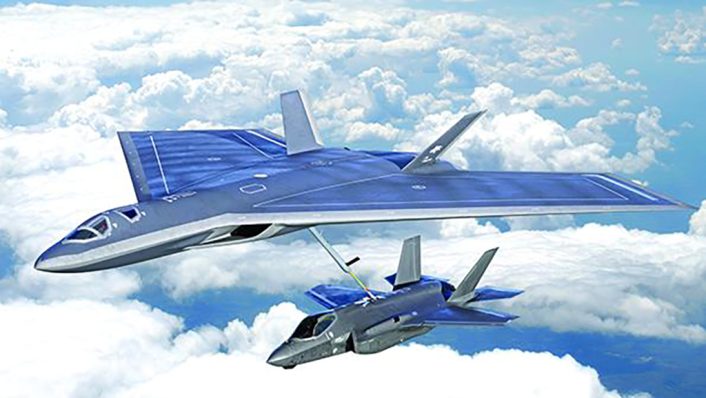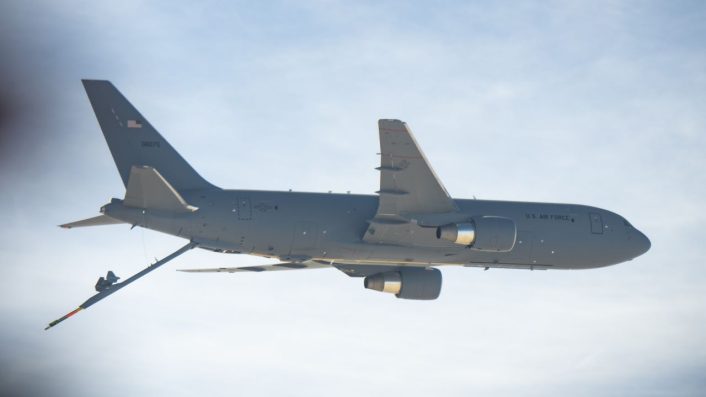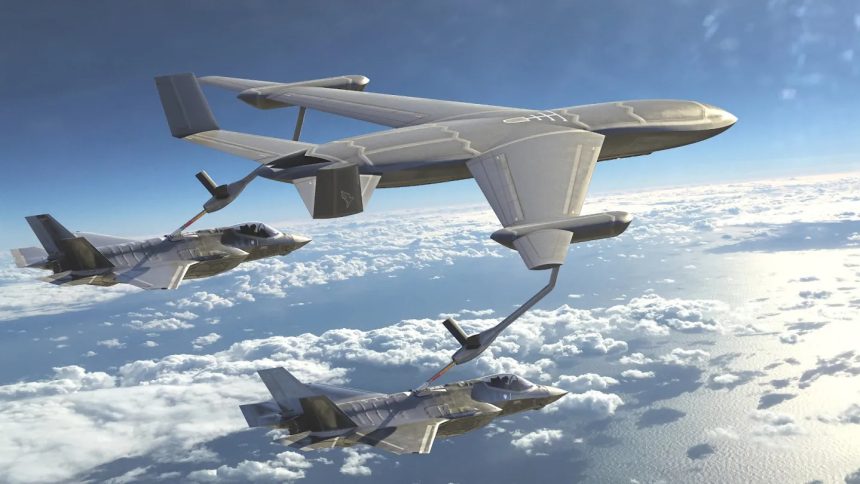The notional concept comes as the U.S. Air Force prepares for an analysis of alternatives for the Next Generation Aerial Refueling System (NGAS).
Lockheed Martin’s secretive Skunk Works division has just released a new notional concept intended for the U.S. Air Force’s Next Generation Aerial Refueling System (NGAS), which is set to pair with the Next Generation Air Dominance (NGAD) fighter and refuel it closer to the frontlines. The concept was first displayed at the recent Airlift/Tanker Association’s (ATA) symposium, with another variant of the rendering later published by The War Zone and Aviation Week.
The NGAS program, also known as KC-Z, aims to replace or complement KC-46 and KC-135 tankers in the 2030s. The program might also include an autonomous tanker for operating in contested environments, or higher-threat areas where existing tankers would not be able to operate in full safety.
Skunk Works’ notional design
The Skunk Works’ concept shows a stealthy design with conventional swept wings and canted outboard vertical stabilizers. Saw-tooth paneling and the now familiar chine line seen on various low-observable designs are evident. A stealthy flat nozzle for one or two engines is visible on the tail, while the inlets might be hidden by the wings and positioned on the sides of the fuselage.
Two sponsons are shown near the wingtips to hold the two flying booms to be used to aerial refuel fighter jets. It’s unclear how the booms will be stowed, although the shape suggests they might retract similarly to the ones installed on current tankers. The angle and dimensions of the boom’s shaft are in fact similar to the angle and dimensions of the sponsons behind the attachment point of the boom.
Another interesting aspect is the absence of a cockpit, as the render shows an unmanned aircraft. However, the reports emerged so far mention that this notional design is optionally manned, although renders of the manned variant aren’t currently available.
Earlier this year, the Skunk Works released another rendering of a notional stealth tanker possibly meant for the NGAS program. That aircraft, based on a rather large lambda wing with canted twin tails, was smaller than the new concept, but it is not clear if the latter is a further development of the former.
“Our team continues to explore a variety of configurations that deliver mission effectiveness through a connected, affordable, survivable and autonomous next generation tanker capability,” said a Skunk Works spokesperson in a statement to The War Zone. “We look forward to providing the U.S. Air Force with the range and endurance needed to fulfill the future of NGAS as it continues to define requirements.”

The Next-Generation Air Refueling System
Last year, the U.S. Air Force released a request for information to the industry for a new tanker capable of surviving in contested airspace, mentioning the service is interested in innovative solutions in all size and performance classes that might address the stressing mission requirements. The service later started an analysis of alternatives.
NGAS will be the third of three increments to the Air Force tanker recapitalization plan, following increment 1 (represented by the KC-46 program) and increment 2 (known as KC-Y or “bridge tanker”). The new tanker would be able to operate closer to the frontlines to better support fighters, while more “traditional” tankers would be employed at a safer distance.
“It’s not one airplane. It’s a system, so it’s not one-size-fits-all. I’m not looking to develop a fleet that has to handle every threat environment,” Gen. Mike Minihan, commander of Air Mobility Command, told reporters earlier this year.
Gen. Minihan previously said he envisions three roles for tankers as part of NGAS. The bulk of the air refueling missions would be performed in a permissive environment by “traditional”, commercial-based tankers such as the KC-46, while a second tanker would operate closer to the fight thanks to improved survivability and connectivity.
The last type, possibly KC-Z, would operate in the same area of operations of fighter jets for high-end missions, so it needs to be small and survivable. Because of this, it needs to have more self-protection and advanced networking than the current types, addressing threats that are posed by potential adversaries to high-value aircraft such as tankers while still being able to perform its air refueling mission.
In addition to refueling, these aircraft might do much more, said Gen. Minihan. In fact, he listed open architecture, autonomy, and battle management capabilities among the things that could be included on the new aircraft. Some of these capabilities might find their way on operational KC-46s even before NGAS enters service.
The plan for the new tankers, however, is not final. Last year, the Air Force said it will buy only 75 tankers as part of the upcoming “Bridge Tanker” and push to field NGAS faster. For sure, funding will get a big role in the plans as the Air Force is already working on big programs such as the B-21 Raider and NGAD and the new tankers need to be fielded “without bankrupting the Air Force,” said Gen. Minihan.

The affordability problems
As the NGAD review is close to the finish and NGAS prepares for the analysis of alternatives, new bad news arise for the programs: no matter the combination, they might all be unaffordable without major changes, according to Aviation Week. In fact, the service’s top priorities right now appear to be the nuclear modernization, Space Force, base defenses and means to attack “adversary’s long-range kill chains.”
“The variable that concerns me the most as we go through this analysis and produce a range of alternatives is going to be the availability of adequate resources to pursue any combination of those new designs,” Air Force Secretary Frank Kendall said. “Right now, given our commitments, our resources and strategic priorities, it is hard for me to see how we can afford any combinations of those new designs. What I worry about the most is the adequacy of our resources.”
Amid sky-rocketing costs, the Air Force is trying to prioritize the allocation of funding for the next fiscal year. While NGAS might considered not urgent because the new KC-46 is still being fielded, it must me noted that the threat scenarios are evolving and high value assets such as the tankers are always at risk, and the Air Force is not taking this lightly.
“Essentially the threat, China again, has reached out with new counter-air systems that could threaten our aircraft, especially tankers, at longer ranges, beyond the ranges which we normally would refuel fighter planes,” Kendall said in a keynote address at the ATA symposium. “This put our whole tanker acquisition strategy in question. It is still in question, but we are working to resolve the uncertainty as quickly as possible.”
Time however is a critical factor, as Kendall warned that, “unfortunately, any new [tanker] design cannot be fielded for several years at best, even if affordable.” Whether this means NGAS will not be able to stay on schedule to field the new tanker in the 2030s is still unclear.









